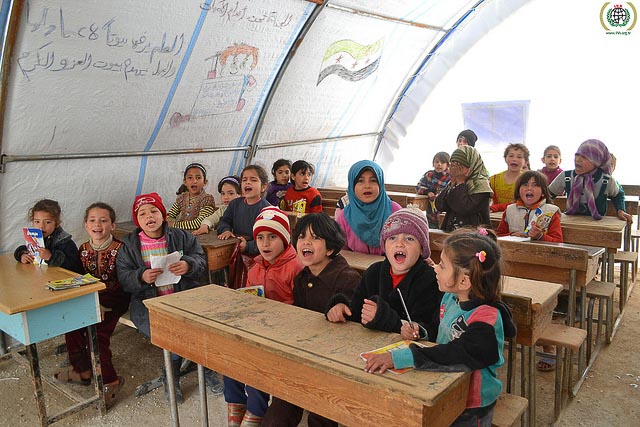Yehuda Sharim is a scholar at the Kinder Institute for Urban Research and a postdoctoral fellow in Jewish Studies at Rice University.
Sharim – a native of Israel whose parents immigrated there from Iran – is developing a multimedia project about refugee communities in Houston.
As the world faces a global refugee crisis, he says, Houston plays a critical role. Indeed, more refugees settle here than in any other U.S. city, according to the Houston Chronicle.
In an interview with the Kinder Institute’s Ryan Holeywell, Sharim explains his project and the conditions facing immigrants when they arrive in Houston.
Ryan Holeywell: How did you become interested in working with refugees?
Yehuda Sharim: It’s always been the focus of my work. I’m from a family of refugee immigrants who came to Israel from Iran. It was a different experience, but I’m aware of the struggles that are acts of migration. It’s about reinventing oneself in a new place, reinventing home when you don’t know what “home” is.
We’re working with communities to humanize and give a face to the experiences most of us don’t know about. Houston is the center of refugees. We receive more refugees than any other city in the U.S. We’ve connected with the resettlement organizations to reach these communities.
We want to work with these refugees and not “about” them. We don’t think of them as “exotic” communities. We’re creating relationships based on trust. We have to interact with and be in dialogue with one another.
RH: How do you make a connection with the refugees you want to interview? Does your camera intimidate them?
YS: I have to take away the mask of being a professor and connect on a personal level by talking about my own family. If I meet a family from Syria and I’m Israeli, that means one thing. But I talk about my dad, who left school at the age of 10 and is a farmer. I talk about things in a different way. There a different sensitivities at play.
It’s not always successful. It always takes time to build trust. I don’t come with the camera the first time. I just talk. Sometimes I don’t operate the camera even on the second or third meeting. It takes a lot of time to build a relationship where people are willing to open up.
You have to expose yourself and talk about your own insecurities. These are people who’ve lost loved ones, who’ve been in a refugee camp for 20 years. There are minors who are on their own and can only see their family through the border, from a distance. I can’t impose anything, but I can offer a sense of healing.
RH: Is it a cathartic for these refugees to share their stories with you?
YS: Sometimes it’s a relief for them. Sometimes it’s a torture chamber. Other time it’s very engaging. Most of the families have loved ones in refugee camps. It all depends.
RH: How do the refugees who are in Houston wind up here?
YS: It’s primarily a target for those who’ve suffered from various health issues. But it ultimately depends on the organizations and where they place them. We’re the fourth largest city, so it shouldn’t be surprising.
Last fiscal year, the U.S. admitted 68,000 refugees. In the early 1980s, it was 200,000. The support they get is for 6 months. I’m looking at when the U.S. did it better.
RH: What are the largest refugee communities in Houston?
YS: They are Afghani, Eritrean, Somali, Congolese, Iraqi, Mexican, Central American, Guatemalan, Salvadoran, Nicaragua, Syrian, Iranian, Burmese, and Bhutanese. It’s a big mix. That diversity is astonishing and beautiful.
RH: Do those groups interact with each other?
YS: That’s the aim of our project. Houstonians, who’ve been immigrants or refugees themselves, can be engaged and help share responsibilities so these people know they’re not alone.
Today there is a deep sense of fear of being able to speak with anyone beyond Facebook. Our inability to interact is limited.
RH: What support do refugees get when they arrive in Houston
YS: There are five resettlement agencies here, and they’re doing an incredible job. Most of the people who work there have been refugees themselves. They’re all overworked.
They’ll pick them up from the airport, help them with their phone and bank accounts, set them up with food stamps, enroll their kids in schools. But with the growing number of refugees and the decreasing support those organizations get, it’s a big gap.
RH: What do you want people to learn from your project?
YS: To know that refugees and immigrants are much more than refugees and immigrants. Think of them as “we,” not “they.” They should not scare us. When someone’s spent 20 years in a refugee camp, it’s our responsibility to engage and interact and listen to them. So the film is a lot about listening, but also the silences and traumas we carry.
RH: Tell me about a particular family that’s left an especially meaningful impression on you.
YS: Imagine you’ve been in a camp for 20 years. In the Congo, in the days of the civil war, you’d run back and forth to the forest for refuge. You go to Kenya, then to another camp in Ethiopia or elsewhere. You don’t know where your dad or some of your siblings are. It’s just you and your mother and younger sisters. And then 10 years down the road, you find yourself in Houston.
Nobody asked if you were interested in coming here. You’re 20. You have no education. That’s the story of one individual I met. He was fascinated at the idea of making films, so I invited him to join our crew.
These are beautiful individuals. We can offer them space and support and help regain our trust in the world. We need to work together to create hope.

